

Scientia Silvae Sinicae ›› 2022, Vol. 58 ›› Issue (2): 159-170.doi: 10.11707/j.1001-7488.20220216
• Research papers • Previous Articles Next Articles
Jia Wang1,2,Xiaojie Liang1,Ming Gao1,Liwen Wu1,Yunxiao Zhao1,Yangdong Wang1,Shiqing Huang3,Yongzhi Zhang3,Huoyong Fu3,Yicun Chen1,*
Received:2020-12-21
Online:2022-02-25
Published:2022-04-26
Contact:
Yicun Chen
CLC Number:
Jia Wang,Xiaojie Liang,Ming Gao,Liwen Wu,Yunxiao Zhao,Yangdong Wang,Shiqing Huang,Yongzhi Zhang,Huoyong Fu,Yicun Chen. Response of Flavonoids Biosynthesis in Roots of Vernicia montana to Fusarium Wilt Infection[J]. Scientia Silvae Sinicae, 2022, 58(2): 159-170.

Fig.1
The inhibition rate of V. fordii and V. montana after Fof-1 infection A: The inhibition rate of V. fordii and V. montana after Fof-1 infection from the 2~9 day. B and C: The inhibition effect of roots extract from V. fordii and V. montana. D and E: The ethyl acetate (extractant) control and blank control."
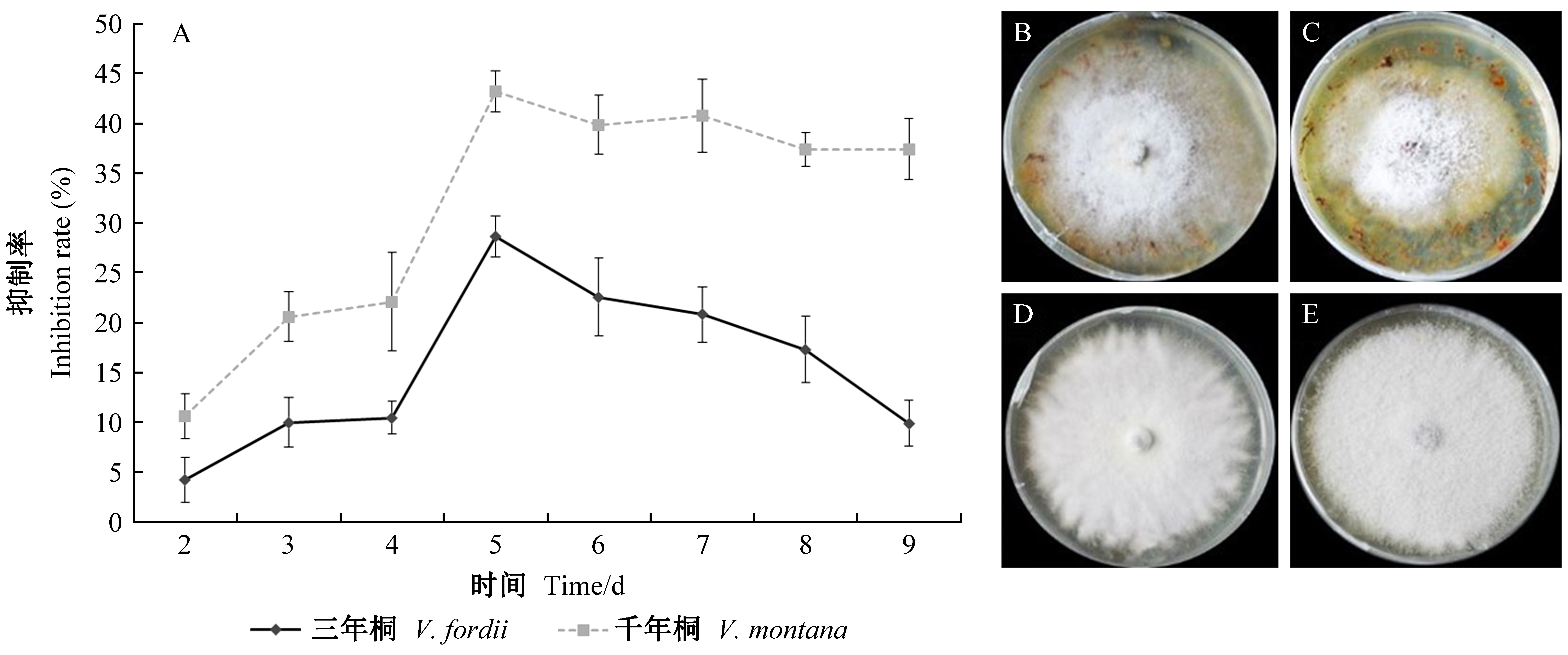
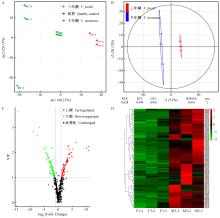
Fig.2
The metabolomics analysis on roots of V. fordii and V. montana after Fof-1 infection A and B: The scores profiles of PCA and PLS-DA analyses on metabolites of root extraction from V. fordii and V. montana, respectively. C: The volcanic plot of 106 up-regulated metabolites and 111 down-regulated metabolites after Fof-1 infection in root of V. montanta. VIP: Variable importance in project. D: The heat map of 106 up-regulated metabolites in V. montana. Red and green bands respectively indicate high and low expression of metabolites in the heat map. The 32 flavonoids were shown in the red boxes. F3-1, F3-2, F3-3 and M3-1, M3-2, M3-3 represent the three independent biological replicates in V. fordii and V. montana."

Table 1
The information of 32 upregulated flavonoids in V. montana root after Fof-1 infection"
| 序号 No. | 化合物名称 Compound name | 物质类别 Category | 变量投影 重要性VIP | 差异倍数 Fold change |
| Ver0746 | 芒柄花苷Formononetin 7-O-glucoside (Ononin) | 异黄酮Isoflavone | 2.237 | 2 026.26 |
| Ver0717 | 橙皮苷Hesperetin 7-rutinoside (Hesperidin) | 黄烷酮Flavanone | 2.150 | 1 185.52 |
| Ver0769 | 高圣草酚Homoeriodictyol | 黄烷酮Flavanone | 1.217 | 2.08 |
| Ver0752 | 枸橘苷Isosakuranetin-7-neohesperidoside (Poncirin) | 黄烷酮Flavanone | 2.225 | 13.06 |
| Ver0725 | 新橙皮苷Hesperetin 7-O-neohesperidoside | 黄烷酮Flavanone | 2.264 | 11.38 |
| Ver0722 | 柚皮素-7-O-葡萄糖苷Naringenin 7-O-glucoside (Prunin) | 黄烷酮Flavanone | 1.032 | 2.51 |
| Ver0712 | 橙皮素O-丙二酰基己糖苷Hesperetin O-malonylhexoside | 黄烷酮Flavanone | 1.631 | 8.80 |
| Ver0711 | 柚皮素7-O-新橘皮糖苷 Naringenin 7-O-neohesperidoside (Naringin) | 黄烷酮Flavanone | 1.329 | 5.24 |
| Ver0726 | 麦黄酮7-O-己糖苷Tricin 7-O-hexoside | 黄酮Flavone | 1.907 | 12.70 |
| Ver0772 | 麦黄酮Tricin | 黄酮Flavone | 1.294 | 2.43 |
| Ver0714 | 麦黄酮5-O-芸香糖苷Tricin 5-O-rutinoside | 黄酮Flavone | 1.261 | 3.42 |
| Ver0684 | 麦黄酮O-葡萄糖二酸Tricin O-saccharic acid | 黄酮Flavone | 1.065 | 2.54 |
| Ver0319 | 麦黄酮O-香草酰己糖苷Tricin O-vanilloylhexoside | 黄酮Flavone | 1.991 | 27.63 |
| Ver0641 | 金合欢素O-乙酰己糖苷Acacetin O-acetyl hexoside | 黄酮Flavone | 1.611 | 7.19 |
| Ver0704 | 金圣草黄素O-乙酰基己糖苷 Chrysoeriol O-acetylhexoside | 黄酮Flavone | 1.244 | 3.32 |
| Ver0706 | 芹菜素7-O-新橘皮糖苷 Apigenin 7-O-neohesperidoside (Rhoifolin) | 黄酮Flavone | 1.007 | 3.29 |
| Ver0330 | 氧甲基金圣草黄素5-O-己糖苷 O-methylChrysoeriol 5-O-hexoside | 黄酮Flavone | 1.150 | 2.86 |
| Ver0733 | 阿福豆苷Kaempferol 3-O-rhamnoside (Kaempferin) | 黄酮醇Flavonol | 1.387 | 4.35 |
| Ver0663 | 二氢杨梅Dihydromyricetin | 黄酮醇Flavonol | 1.671 | 9.71 |
| Ver0681 | 杨梅苷Myricetin 3-O-rhamnoside (Myricitrin) | 黄酮醇Flavonol | 1.471 | 5.15 |
| Ver0702 | 三叶豆甙Kaempferol 3-O-galactoside (Trifolin) | 黄酮醇Flavonol | 1.640 | 8.54 |
| Ver0284 | 异鼠李素5-O-己糖苷Isorhamnetin 5-O-hexoside | 黄酮醇Flavonol | 1.239 | 3.58 |
| Ver0720 | 紫云英苷Kaempferol 3-O-glucoside (Astragalin) | 黄酮醇Flavonol | 2.104 | 15.36 |
| Ver0773 | 丁香亭Syringetin | 黄酮醇Flavonol | 1.513 | 4.06 |
| Ver0197 | 天竺葵色素苷Pelargonin | 花青素Anthocyanins | 1.244 | 3.32 |
| Ver0196 | 锦葵色素苷Malvidin 3, 5-diglucoside (Malvin) | 花青素Anthocyanins | 1.350 | 4.13 |
| Ver0178 | 花青素苷Cyanidin 3, 5-O-diglucoside (Cyanin) | 花青素Anthocyanins | 1.418 | 3.92 |
| Ver0206 | 矢车菊素3-O-芸香糖苷 Cyanidin 3-O-rutinoside (Keracyanin) | 花青素Anthocyanins | 1.776 | 10.40 |
| Ver0650 | 原花青素B2 Procyanidin B2 | 原花青素Proanthocyanidins | 1.330 | 3.87 |
| Ver0636 | 原花青素B3 Procyanidin B3 | 原花青素Proanthocyanidins | 1.305 | 3.72 |
| Ver0276 | 芥子酰羟基香豆素 N-sinapoyl hydroxycoumarin | 香豆素及其衍生物Coumarins | 1.603 | 9.04 |
| Ver0730 | 7-羟基香豆素鼠李糖苷 7-hydroxycoumarin-β-rhamnoside | 香豆素及其衍生物Coumarins | 1.528 | 3.46 |
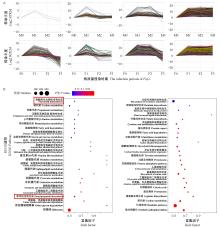
Fig.3
The transcriptome analysis between V. fordii and V. montana after Fof-1 infection. A: The up-regulated expression mode of genes in the roots of V. montana upon the Fof-1 infection at the early stage (F1, M1). M0 and F0 represent uninfected V. montana and V. fordii; M1 and F1 represent the early stage of Fof-1 infection; M2 and F2 represent the middle stage of infection; M3 and F3 represent the late stage of infection. B: The scatter diagram of KEGG enrichment on differentially expressed genes at the early stage of Fof-1 infection."

Table 2
The information of differentially expressed genes involved in the pathways of phenylpropanoid and flavonoids biosynthesis in the roots of V. montana"
| 编码基因代码 Gene code | 编码蛋白功能注释 Coding protein annotation | KEGG号 KEGG No. |
| 苯丙烷类生物合成途径Phenylpropanoidbiosynthesis | ||
| comp160842_c0 | 2-氧戊二酸依赖性双加氧酶AOP1 2-oxoglutarate-dependent dioxygenase AOP1 | K06892 |
| comp164220_c0 | 4-香豆酸:CoA连接酶-7 (4CL-like 7) 4-coumarate: CoA ligase-like 7 (4CL-like 7) | K01904 |
| comp158232_c0 | 咖啡酰-CoA O-甲基转移酶(CCoAOMT At4g26220)caffeoyl-CoA O-methyltransferase | K00588 |
| comp158238_c0 | 咖啡酰-CoA O-甲基转移酶(CCoAOMT At4g26220)caffeoyl-CoA O-methyltransferase | K00588 |
| comp148821_c0 | 木质素形成阴离子过氧化物酶Lignin-forming anionic peroxidase-like | K00430 |
| comp153555_c0 | 木质素形成阴离子过氧化物酶Lignin-forming anionic peroxidase-like | K00430 |
| comp162769_c1 | 木质素形成阴离子过氧化物酶Lignin-forming anionic peroxidase-like | K00430 |
| comp149644_c0 | 过氧化物酶Peroxidase (POX) | K00430 |
| comp156697_c0 | 过氧化物酶Peroxidase (POX) | K00430 |
| comp156748_c0 | 过氧化物酶Peroxidase (POX) | K00430 |
| comp178040_c0 | 过氧化物酶Peroxidase (POX) | K00430 |
| comp48864_c0 | 过氧化物酶Peroxidase (POX) | K00430 |
| comp57178_c0 | 过氧化物酶Peroxidase (POX) | K00430 |
| comp152363_c0 | 过氧化物酶-12 Peroxidase 12-like (POX 12-like) | K00430 |
| comp59499_c0 | 过氧化物酶-15 Peroxidase 15-like (POX 15-like) | K00430 |
| comp160671_c0 | 过氧化物酶-4 Peroxidase 4 (POX 4) | K00430 |
| comp162281_c0 | 过氧化物酶-4 Peroxidase 4 (POX 4) | K00430 |
| comp158600_c0 | 过氧化物酶-A2 Peroxidase A2-like (POX A2-like) | K00430 |
| comp161309_c0 | 过氧化物酶-A2 Peroxidase A2-like (POX A2-like) | K00430 |
| comp115360_c0 | 过氧化物酶N1 Peroxidase N1 (POX N1) | K00430 |
| comp166753_c0 | 丝氨酸羧肽酶-8 Serine carboxypeptidase-like 18 (SCP-like 18) | K09756 |
| comp166459_c0 | 丝氨酸羧肽酶-7 Serine carboxypeptidase-like 7 (SCP-like 7) | K09756 |
| comp162378_c0 | 反式肉桂酸4-单加氧酶Trans-cinnamate 4-monooxygenase | K00487 |
| comp48140_c0 | β-D-葡萄糖基番红花素β-1, 6-葡萄糖基转移酶β-D-glucosyl crocetin beta-1, 6-glucosyltransferase-like | K12356 |
| comp163132_c0 | β-D-木糖苷酶β-D-xylosidase (β-D-XYL) | K05349 |
| comp62881_c0 | β-葡萄糖苷酶β-glucosidase (BGL) | K05350 |
| comp147485_c0 | β-葡萄糖苷酶18 β-glucosidase 18 (BGL 18) | K05350 |
| comp147998_c0 | β-葡萄糖苷酶18 β-glucosidase 18 (BGL 18) | K05350 |
| comp165691_c0 | β-葡萄糖苷酶41 β-glucosidase 41 (BGL 41) | K01188 |
| comp161549_c0 | β-葡萄糖苷酶44 β-glucosidase 44 (BGL 44) | K05350 |
| 黄酮类生物合成途径Flavonoids biosynthesis | ||
| comp145399_c0 | 黄酮类3-单加氢酶Flavonoid 3-monooxygenase | K05280 |
| comp151069_c0 | 黄酮类3-单加氢酶Flavonoid 3-monooxygenase | K05280 |
| comp158232_c0 | 咖啡酰-CoA O-甲基转移酶(CCoAOMT At4g26220)caffeoyl-CoA O-methyltransferase | K00588 |
| comp158238_c0 | 咖啡酰-CoA O-甲基转移酶(CCoAOMT At4g26220)caffeoyl-CoA O-methyltransferase | K00588 |
| comp162378_c0 | 反式肉桂酸4-单加氧酶Trans-cinnamate 4-monooxygenase | K00487 |
| comp163230_c1 | 黄酮醇合酶Flavonol synthase | K05278 |
| comp163517_c0 | 柚皮素3-双加氧酶Naringenin 3-dioxygenase | K00475 |

Fig.4
Gene network analysis of hub genes in phenylpropanoid biosynthesis pathways responding to Fof-1 infection in V. montana. A: Gene network of four hub genes correlated with other 1 625 genes in phenylpropanoid biosynthesis pathways responding to Fof-1 infection in V. montana. The red V represents the hub genes and the black spots represent the correlated 1 625 genes. B: The KEGG annotation for the 1 625 genes."
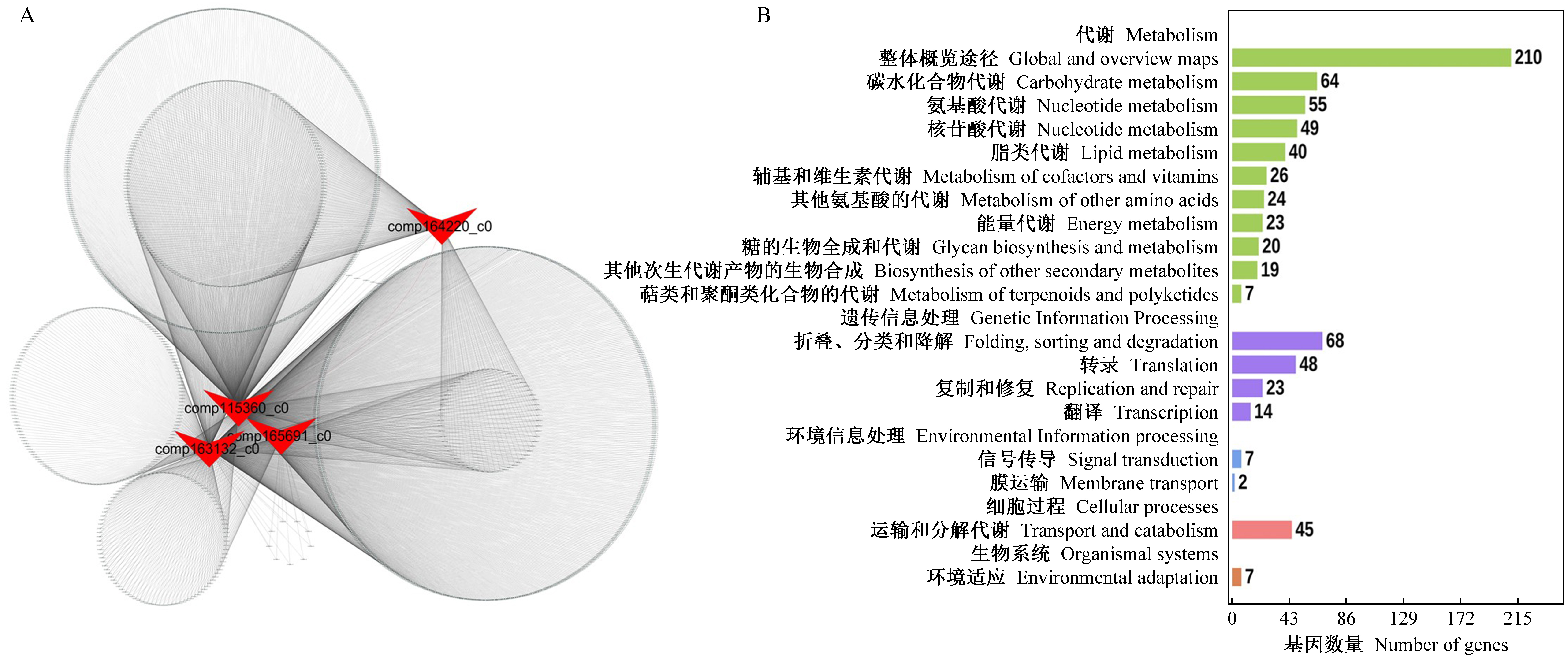
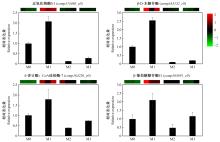
Fig.5
Expression mode identification of 4 hub genes by qRT-PCR in V. montana. M0 represents uninfected V. montana; M1 represents the early stage of Fof-1 infection; M2 represents the middle stage of infection; M3 represents the late stage of infection. The heatmap up the histogram shows the relative gene expression level by RNA seq. Red represents the higher expression level; Green represents the lower expression level."

| 方嘉兴, 何方, 姚小华. 中国油桐. 北京: 中国林业出版社, 2017. | |
| Fang J X , He F , Yao X H . Chinese tung oil tree. Beijing: China Forestry Publishing House, 2017. | |
| 杨素素, 高暝, 朱慧萍, 等. 三年桐、千年桐感染枯萎病病原菌后的生理反应. 林业科学研究, 2014, 27 (6): 752- 757. | |
| Yang S S , Gao M , Zhu H P , et al. Physiological response of Vernicia fordi and V. montana upon inoculation with Fusarium oxysporum. Forest Research, 2014, 27 (6): 752- 757. | |
| 于利, 张彦, 陈爱国, 等. 烟草苯丙烷代谢途径关键酶肉桂酸-4-羟化酶, 4-香豆酸-辅酶A基因的分离及表达特性分析. 植物遗传资源学报, 2014, 15 (5): 1067- 1073. | |
| Li Y , Zhang Y , Chen A G , et al. Isolation and expression analysis of Ntc4h and Nt4cl encoding the key enzymes of phenylalanine metabolism pathway in tobacco. Journal of Plant Genetic Resources, 2014, 15 (5): 1067- 1073. | |
|
Bai Q X , Duan B B , Ma J C , et al. Coexpression of PalbHLH 1 and PalMYB90 genes from Populus alba enhances pathogen resistance in poplar by increasing the flavonoid content. Frontiers in Plant Science, 2020, 10, 1772.
doi: 10.3389/fpls.2019.01772 |
|
| Chen X H , Su W L , Zhang H , et al. Fraxinus mandshurica 4-coumarate-CoA ligase 2 enhances drought and osmotic stress tolerance of tobacco by increasing coniferyl alcohol content. Plant Physiology & Biochemistry, 2020, 155, 697- 708. | |
|
Chen X H , Wang H T , Li X Y , et al. Molecular cloning and functional analysis of 4-Coumarate: CoA ligase 4 (4CL-like 1) from Fraxinus mandshurica and its role in abiotic stress tolerance and cell wall synthesis. BMC Plant Biology, 2019, 19 (1): 231.
doi: 10.1186/s12870-019-1812-0 |
|
| Chen Y C , Yin H F , Gao M , et al. Comparative transcriptomics atlases reveals different gene expression pattern related to Fusarium wilt disease resistance and susceptibility in two Vernicia species. Frontiers in Plant Science, 2016, 7, 1974. | |
|
Chen Y H , Zhang R P , Song Y M , et al. RRLC-MS/MS-based metabonomics combined with in-depth analysis of metabolic correlation network: finding potential biomarkers for breast cancer. Analyst, 2009, 134 (10): 2003- 2011.
doi: 10.1039/b907243h |
|
| Dean R , Van Kan J A , Pretorius Z A , et al. The top 10 fungal pathogens in molecular plant pathology. Molecular Plant Pathology, 2012, 13 (7): 414- 430. | |
|
Du Y G , Chu H , Wang M F , et al. Identification of flavone phytoalexins and a pathogen-inducible flavone synthase II gene (SbFNSII) in Sorghum. Journal of Experimental Botany, 2010, 61 (4): 983- 994.
doi: 10.1093/jxb/erp364 |
|
|
Fang X Y , Dong Y R , Xie Y Y , et al. Effects of β-glucosidase and α-rhamnosidase on the contents of flavonoids, ginkgolides, and aroma components in ginkgo tea drink. Molecules, 2019, 24 (10): 2009.
doi: 10.3390/molecules24102009 |
|
|
Gayatridevi S , Jayalakshmi S K , et al. Salicylic acid is a modulator of catalase isozymes in chickpea plants infected with Fusarium oxysporum f. sp. ciceri. Plant Physiology Biochemistry, 2012, 52, 154- 161.
doi: 10.1016/j.plaphy.2011.12.005 |
|
| Gill U S , Uppalapati S R , Gallego-Giraldo L , et al. Metabolic flux towards the (iso)flavonoid pathway in lignin modified alfalfa lines induces resistance against Fusarium oxysporumf. sp. medicaginis.. Plant Cell and Environment, 2018, 41 (9): 1997- 2007. | |
|
He Y Z , Han J W , Liu R S , et al. Integrated transcriptomic and metabolomic analyses of a wax deficient citrus mutant exhibiting jasmonic acid-mediated defense against fungal pathogens. Horticulture Research, 2018, 5 (1): 43.
doi: 10.1038/s41438-018-0051-0 |
|
|
Hou J , Wu Q M , Zuo T , et al. Genome-wide transcriptomic profiles reveal multiple regulatory responses of poplar to Lonsdalea quercina infection. Trees, 2016, 30 (4): 1389- 1402.
doi: 10.1007/s00468-016-1376-7 |
|
|
Karre S , Kumar A , Yogendra K , et al. HvWRKY23 regulates flavonoid glycoside and hydroxycinnamic acid amide biosynthetic genes in barley to combat Fusarium head blight. Plant Molecular Biology, 2019, 100 (6): 591- 605.
doi: 10.1007/s11103-019-00882-2 |
|
| Król P , Igielski R , Pollmann S , et al. Priming of seeds with methyl jasmonate induced resistance to hemi-biotroph Fusarium oxysporum f. sp. lycopersici in tomato via 12-oxo-phytodienoic acid, salicylic acid, and flavonol accumulation. Journal of Plant Physiology, 2015, 179 (1): 122- 132. | |
| Liu L , He X J , Zhang Z M , et al. Cloning and Expression of the serine carboxypeptidase gene in Zea mays and its antifungal activity against Rhizoctonia solani. Journal of Life Sciences, 2013, 7 (2): 123- 130. | |
|
Li S S , Chang Y , Li B , et al. Functional analysis of 4-coumarate: CoA ligase from Dryopteris fragrans in transgenic tobacco enhances lignin and flavonoids. Genetics and Molecular Biology, 2020, 43 (2): e20180355.
doi: 10.1590/1678-4685-gmb-2018-0355 |
|
|
Li Y , Li G D , Yu H T , et al. Antifungal activities of isoflavonoids from Uromyces striatus infected alfalfa. Chem Biodivers, 2018, 15 (12): e1800407.
doi: 10.1002/cbdv.201800407 |
|
|
Mageroy M H , Parent G , Germanos G , et al. Expression of the β-glucosidase gene Pgβglu-1 underpins natural resistance of white spruce against spruce budworm. The Plant Journal, 2015, 81, 68- 80.
doi: 10.1111/tpj.12699 |
|
|
Tang N , Chen N , Hu N , et al. Comparative metabonomics and transcriptomic profiling reveal the mechanism of fruit quality deterioration and the resistance of citrus fruit against Penicillium digitatum. Postharvest Biology and Technology, 2018, 145, 61- 73.
doi: 10.1016/j.postharvbio.2018.06.007 |
|
|
Thévenot E A , Roux A , Xu Y , et al. Analysis of the human adult urinary metabolome variations with age, body mass index, and gender by implementing a comprehensive workflow for univariate and OPLS statistical analyses. Journal of Proteome Research, 2015, 14, 3322- 3335.
doi: 10.1021/acs.jproteome.5b00354 |
|
|
Wagner A , Tobimatsu Y , Phillips L , et al. CCoAOMT suppression modifies lignin composition in Pinus radiata. Plant Journal, 2011, 67, 119- 129.
doi: 10.1111/j.1365-313X.2011.04580.x |
|
|
Xiong J S , Balland-Vanney M , Xie Z P , et al. Molecular cloning of a bifunctional beta-xylosidase/alpha-L-arabinosidase from alfalfa roots: heterologous expression in Medicago truncatula and substrate specificity of the purified enzyme. Journal of Experimental Botany, 2007, 58 (11): 2799- 2810.
doi: 10.1093/jxb/erm133 |
|
|
Yang F , Li M Q , Xin Y Y , et al. Effects of flavonoids from potato-onion on Fusarium wilt fungus of tomato. Allelopathy Journal, 2019, 47 (1): 119- 126.
doi: 10.26651/allelo.j/2019-47-1-1225 |
|
|
Yang Y , Jiang R , Wang H Y , et al. StPOPA, encoding an anionic peroxidase, enhances potato resistance against Phytophthora infestans. Molecular Breeding, 2020, 40 (2): 16.
doi: 10.1007/s11032-019-1093-1 |
|
|
Yin L H , Zou Y J , Ke X W , et al. Phenolic responses of resistant and susceptible Malus plants induced by Diplocarpon mali. Scientia Horticulturae, 2013a, 164, 17- 23.
doi: 10.1016/j.scienta.2013.08.037 |
|
| Yin L , Zou Y J , Li M J , et al. Resistance of Malus plants to Diplocarpon mali infection is associated with the antioxidant system and defense signaling pathways. Physiological & Molecular Plant Pathology, 2013b, 84, 146- 152. | |
| Zhao L , Phuong L T , Luan M T , et al. A class Ⅲ peroxidase PRX34 is a component of disease resistance in Arabidopsis. Journal of General Plant Pathology, 2019, 85 (6): 1- 8. |
| [1] | Wei Qi, Wang Shuying, Tang Feng, Zhang Huaxin, Yu Jin, Yue Yongde. Simultaneous Determination of 13 Flavonoids in Bamboo Leaves by HPLC [J]. Scientia Silvae Sinicae, 2015, 51(8): 81-87. |
| [2] | Wang Chuanhong, Liu Chao, Liu Jing, Xiang Wei, Huang Xianzhi, Xu Li. Antioxidant Activity of Medicine Mulberry (Morus nigra) in Xinjiang [J]. Scientia Silvae Sinicae, 2014, 50(8): 53-59. |
| [3] | Wei Qi, Yue Yongde, Tang Feng, Sun Jia. Comparison of Flavonoids in the Leaves of Three Genera of Bamboo [J]. Scientia Silvae Sinicae, 2013, 49(10): 127-134. |
| [4] | Liu Yumin;Liu Yamin;Ma Ming;He Binghui;Li Changxiao. Analysis of Relevant Physiological and Biochemical Characteristics of Pinus massoniana During Cuttings Rooting [J]. Scientia Silvae Sinicae, 2010, 46(9): 28-33. |
| [5] | Dong Juan'e;Du Hongyan;Zhang Kangjian;Zhao Hui;Li Zhouqi;Shao Zhanbo;Peng Shaobing. Selection of Ornamental and Officinal Clones of Eucommia ulmoides [J]. Scientia Silvae Sinicae, 2008, 44(5): 165-169. |
| [6] | Cheng Shuiyuan;Wang Yan;Li Junkai;Fei Yongjun;Zhu Guicai. Study on the Relationship between the Endogenous Hormones and Flavonoids in Ginkgo biloba Leaf [J]. Scientia Silvae Sinicae, 2004, 40(6): 45-49. |
| [7] | Cheng Shuiyuan;Wang Yan;Li Junkai;Gu Manru;Shu Huairui. STUDY ON THE SYNTHESIS AND METABOLISM OF THE FLAVONOIDS IN GINKGO BILOBA LEAF [J]. Scientia Silvae Sinicae, 2002, 38(5): 60-63. |
| [8] | Cheng Shuiyuan;Gu Manru;Shu Huairui. ADVANCES IN RESEARCH ON FLAVONOIDS IN GINKGO BILOBA LEAF [J]. Scientia Silvae Sinicae, 2000, 36(6): 110-115. |
| Viewed | ||||||
|
Full text |
|
|||||
|
Abstract |
|
|||||